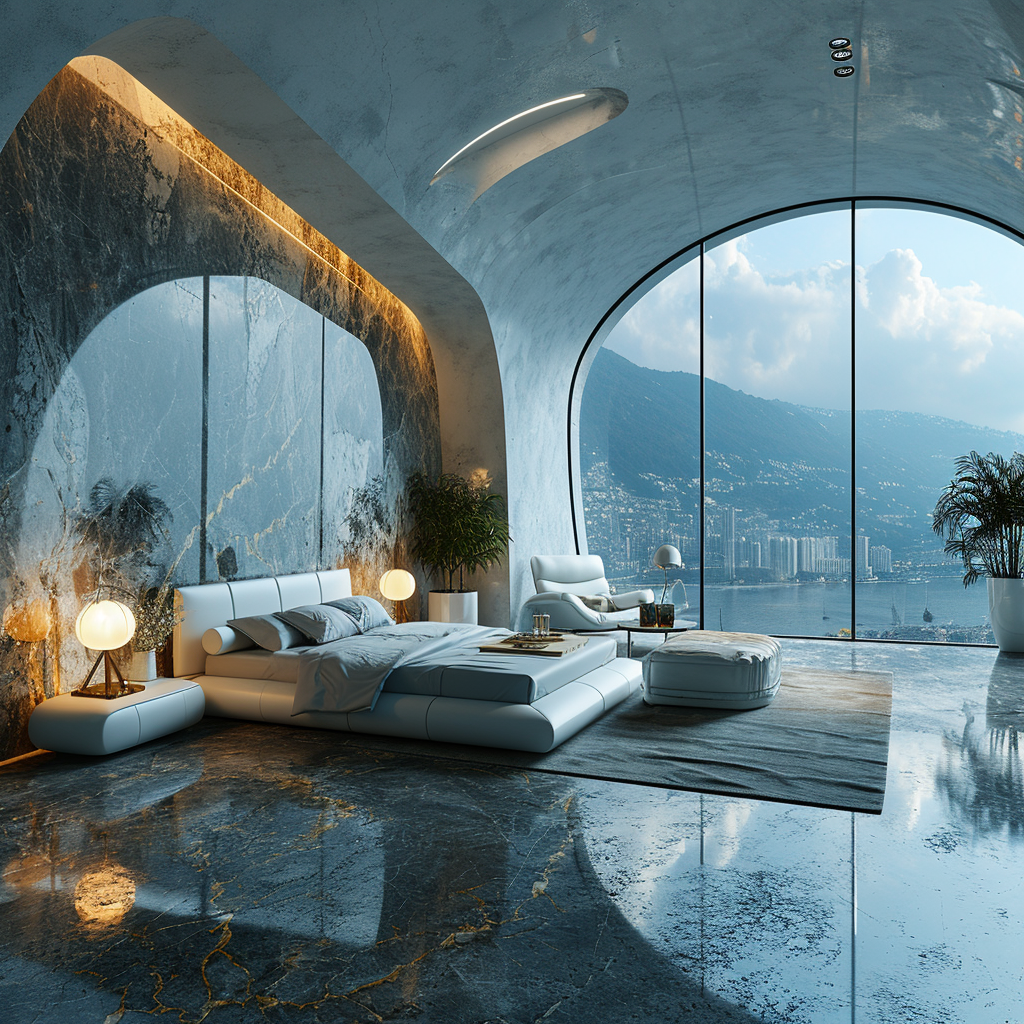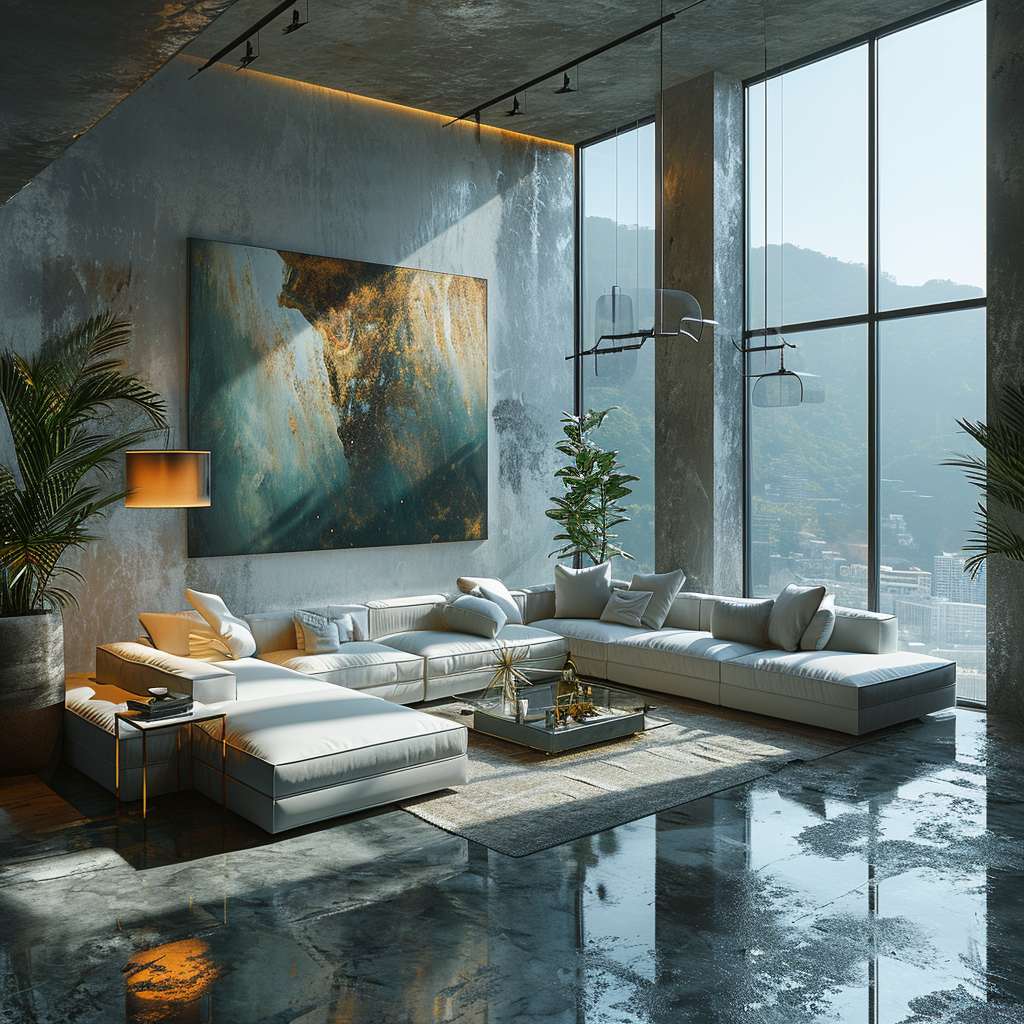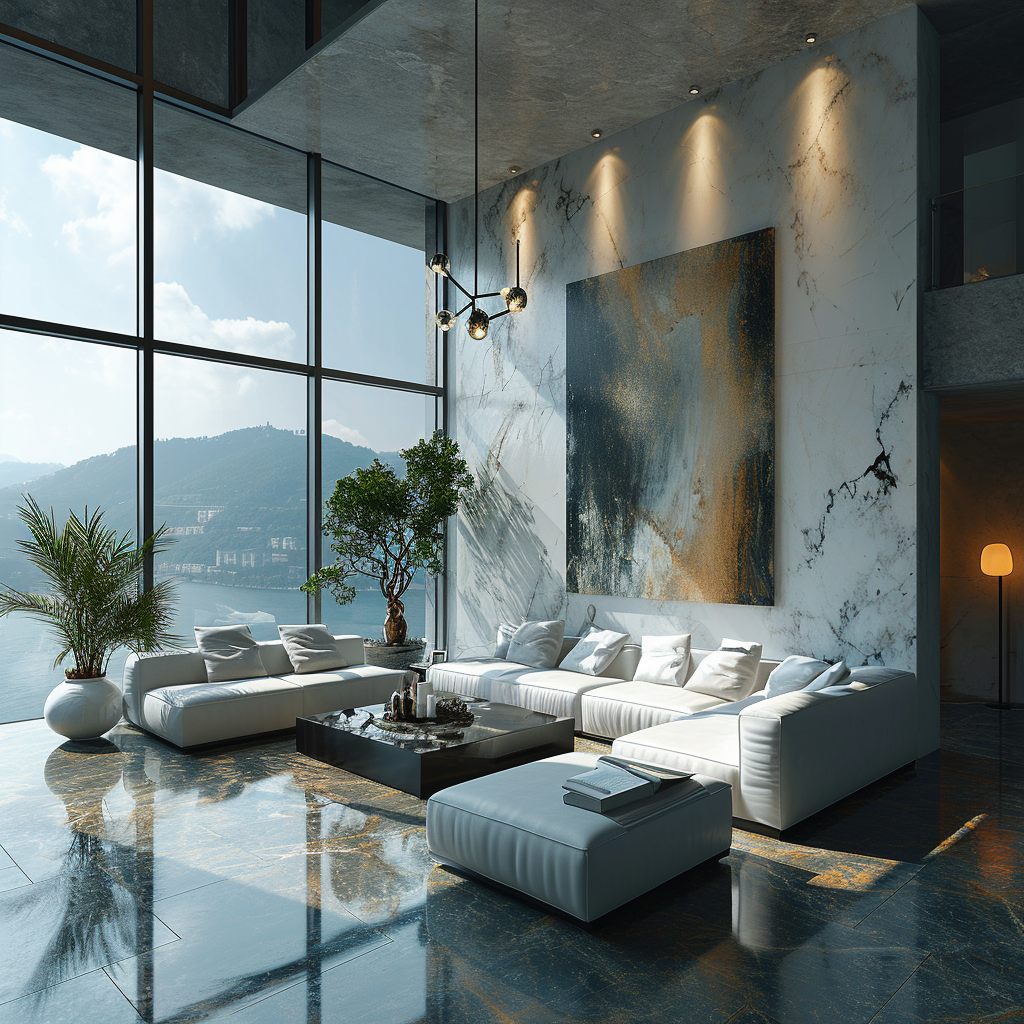2024 sees a big trend in home design: Aquatecture. It's all about adding water features and ocean themes to your home, popular with Gen X and Millennials. This trend brings a calm, modern feel to any room. It's more than just looks; it's about creating peaceful spaces in our busy lives. Want to know how this trend can change your home? Keep reading for simple, stunning ideas.
Introduction to Aquatecture

Aquatecture combines fluid design principles with elements inspired by water, from tranquil indoor water features to flowing architectural lines, mirroring the calming and rejuvenating qualities of water.
1. Water as a Central Design Element in Home Design Ideas
In the realm of Aquatecture, the application of water elements extends to various aspects of home design. In modern bedroom design, for instance, the incorporation of aquariums or water-themed art can transform the room into a soothing sanctuary, perfect for unwinding after a long day. In traditional living rooms, water features can be subtly integrated to add a touch of elegance and fluidity, enhancing the room's aesthetics without overpowering the classic feel.
The beauty of water as a design element lies in its versatility. It can be bold and prominent, like a central courtyard pool reflecting the sky, or it can be understated, like a small zen fountain in a quiet corner. This adaptability makes water a suitable choice for a wide range of interior design styles, from minimalist to maximalist, from modern to traditional.
Moreover, with the rise of interior design services and home design online platforms, integrating water elements into home design has become more accessible. Homeowners can now explore various ways to incorporate water features into their living spaces, guided by professional advice and online resources, ensuring that their home not only follows the latest trends but also resonates with their personal style and preferences.
2. Design Your Room with Fluid Architectural Lines

Fluid architectural lines bring a dynamic and organic feel to spaces, breaking free from the conventional boxy layouts. Imagine walking into a room where the walls gently curve, guiding your gaze in a smooth, uninterrupted flow, or looking up at a ceiling that undulates subtly, reminiscent of the waves of an ocean or the rolling hills of a landscape. This design strategy is not only visually striking but also creates a sense of openness and movement, making spaces feel more expansive and connected to the natural world.
Incorporating fluid lines into home design can be seen in various applications. It might manifest in the sweeping curves of a staircase, the rounded edges of countertops, or even in the layout of the rooms themselves. Furniture and decor in these spaces often mirror this philosophy, featuring rounded, organic shapes that complement the architectural lines.
With the rise of technology and innovative construction techniques, implementing fluid architectural lines has become more feasible and popular. These designs often require a blend of creative vision and engineering prowess, making them a hallmark of modern architectural achievement.
3. Aquatic Color Palettes and Textures In Bedroom and Living Room Design Ideas
Aquatecture draws inspiration from the diverse and mesmerizing hues of water bodies, translating them into a color scheme that evokes tranquility, depth, and fluidity. Aquatic color palettes are not just about blue; they encompass a range of shades from the deep, mysterious navy of the ocean depths to the soft, soothing turquoise of shallow tropical waters, and even the neutral tones of sandy beaches and pebbles.
Incorporating these colors into interior design creates a serene and refreshing ambiance. Imagine a living room design where soft blues and greens are complemented by sandy beiges, creating a space that feels like an extension of a peaceful seaside retreat. In modern bedroom designs, these aquatic hues can be used to craft a restful sanctuary, with textiles and wall colors reflecting the calming qualities of water.
Textures in Aquatecture are equally important and are inspired by the varied surfaces seen in aquatic environments. This could range from the smooth, reflective quality of still water mirrored in glossy finishes and sleek materials, to the rough, organic feel of coral or driftwood incorporated through textured wallpapers, fabrics, or decor items. The play of light on these textures can further enhance the feeling of being connected to water, mimicking the way sunlight dances on the surface of a river or sea.
The integration of aquatic colors and textures is also an opportunity to experiment with layering and depth. Different shades can be layered to create a dynamic, immersive experience, much like the layers of color one might see in a cross-section of the ocean. Textures add to this by providing a tactile dimension, allowing for a space that is not only visually engaging but also comforting to touch.
4. Sustainable and Eco-Friendly Practices In Modern Interior Design

Sustainable Aquatecture integrates eco-friendly materials, energy-efficient designs, and practices that support a healthier environment, both inside the home and in the wider world.
One key aspect of sustainable Aquatecture is the use of materials that are renewable, recycled, or have a low environmental impact. This could mean choosing bamboo or cork flooring, which are both sustainable and reminiscent of watery textures, or using recycled glass tiles that mimic the shimmer of water in bathrooms and kitchens. Furniture and decor made from reclaimed wood or recycled materials also fit seamlessly into the aquatic theme, adding character while reducing waste.
Energy efficiency is another critical component. This can be achieved through smart architectural design that maximizes natural light and ventilation, reducing the need for artificial lighting and air conditioning. Incorporating water elements like indoor ponds or water walls can also contribute to a home’s microclimate, naturally cooling the air and improving humidity levels.
Water conservation is particularly relevant in Aquatecture. Techniques like rainwater harvesting, using water-efficient appliances, and installing low-flow fixtures ensure that the water theme in the home doesn’t come at an environmental cost. Landscaping too can be designed with sustainability in mind, using native plants that require less water and creating natural runoff areas that help replenish groundwater.
In addition to these practical measures, sustainable Aquatecture also involves a philosophical shift. It encourages homeowners and designers to think about how a space connects with its natural surroundings, fostering a sense of respect and stewardship for the environment. This could manifest in design choices that blend indoor and outdoor spaces, or in the use of biophilic design principles that emphasize a direct connection to nature.
5. Custom-Made Aquatic Furniture With Online Interior Design
In creating these unique pieces, designers and craftsmen draw inspiration from various aspects of water. For example, a custom coffee table might feature a glass top that mimics the surface of a calm lake, with undulating wooden or metal bases that resemble gentle waves or flowing river patterns. Chairs and sofas may be designed with flowing lines and upholstered in fabrics that boast the colors and textures of the sea, like deep blues, soft greens, or shimmering silvers.
The materials used in custom aquatic furniture are chosen not only for their aesthetic qualities but also for their ability to convey the essence of water. This could include the use of reflective surfaces like glass and polished metals to mimic water’s reflective nature, or the incorporation of organic materials like driftwood or stone that connect the piece to natural water environments.
Custom-made aquatic furniture also offers a level of personalization that resonates with those looking to create a unique space. Homeowners can collaborate with designers to incorporate specific aquatic themes, colors, or materials that hold personal meaning or complement the existing decor of their homes. This collaboration results in pieces that are not just functional but also deeply personal, enhancing the emotional connection between the space and its inhabitants.
6. Lighting to Reflect Water’s Essence

Designers are innovatively using lighting to mimic the way light interacts with water. One example is the use of undulating, wave-like light fixtures that cast a gentle, flowing pattern on walls and ceilings, reminiscent of sunlight dancing on the surface of water. These fixtures not only provide light but also contribute to the room's overall aquatic theme, enhancing the sense of being connected to a natural water environment.
Another technique is the strategic placement of lighting to reflect off surfaces that mimic water, such as glossy tiles, reflective metals, or glass elements. This reflection can create a shimmering effect, similar to light refracting through water, adding depth and movement to the space. Ambient lighting in shades of blue or green can also be used to evoke the feeling of being underwater, providing a soothing, immersive experience.
Incorporating lighting elements that physically interact with water is yet another innovative approach. For instance, incorporating small LED lights into indoor fountains or water features can create a captivating visual display, as the light and water interact dynamically, creating sparkling and rippling effects.
Beyond aesthetics, the lighting in Aquatecture is also about sustainability and efficiency. Utilizing energy-efficient LED lights and smart lighting systems not only reduces the environmental impact but also mirrors the natural, unobtrusive quality of light in aquatic settings.
7. Integrating Natural Water Elements In Coastal Interior Designs
One popular method is the inclusion of indoor water features, such as fountains, waterfalls, or even small indoor ponds. These features serve as focal points in a room, immediately drawing the eye and creating a sense of calm with the gentle sound of flowing water. They can vary in size and design, from minimalist and modern to more elaborate and ornate, depending on the overall style of the space.
Another way to integrate natural water elements is through the use of aquariums. Large, built-in aquariums can act as living art installations, adding vibrant life and movement to a room. Smaller aquariums, strategically placed, can also add a touch of aquatic tranquility without overwhelming the space. In either case, the presence of aquatic life adds an extra dimension of nature and serenity to the home.
Outdoor-to-indoor water elements are also gaining popularity, where exterior water features like ponds or streams are designed to seamlessly transition into the interior of the home. This design technique blurs the lines between indoor and outdoor spaces, making water a unifying element that enhances the overall harmony and flow of the living environment.
The use of natural materials in these water features, such as stones, pebbles, and plants, further strengthens the connection to the natural world. These materials not only complement the water elements aesthetically but also contribute to a more organic and authentic feel.
8. Technology in Aquatecture

Smart technology plays a pivotal role in this trend. Automated systems can control water features, adjusting flow, lighting, and even sound for optimal ambiance and energy efficiency. Imagine a fountain or indoor waterfall that can be adjusted with a smartphone app, allowing homeowners to create different moods at the touch of a button. These systems can also be integrated into home automation for a cohesive and convenient control experience.
Another technological advancement in Aquatecture is the use of sustainable and energy-efficient materials and systems. This includes solar-powered water features and eco-friendly filtration systems that maintain clean, circulating water with minimal environmental impact. LED lighting in water elements is another example, offering long-lasting, energy-efficient illumination that enhances the water’s visual appeal.
9. Artistic Aquatecture Accents

Artistic Aquatecture Accents can take many forms, each adding a unique touch to the home's ambiance. Wall-mounted water art, for instance, combines the soothing presence of water with visually stunning designs, creating moving artworks that captivate and soothe the viewer. These pieces can range from abstract interpretations of water flow to more literal depictions of aquatic scenes, crafted with materials that catch and reflect light to mimic the movement of water.
Incorporating sculptural elements into water features is another way to add an artistic flair. Sculptures that interact with water, whether by channeling its flow or appearing to emerge from it, create a focal point that is both a water feature and a piece of art. These sculptures can be custom-made, offering a chance for homeowners to infuse personal or cultural significance into their space.
Even the smaller accents, like bespoke aquarium decorations or handcrafted water-themed tiles, contribute to the overall artistic narrative of the space. These details, though subtle, add layers of meaning and beauty, enriching the aquatic theme.
Conclusion: Dive into Aquatecture with Hestya

As we've explored the rich and varied facets of Aquatecture in 2024, from the integration of natural water elements to the use of advanced technology and artistic accents, it's clear that this trend represents a profound shift in home design. Aquatecture is not just about incorporating water into our spaces; it's about reimagining the way we interact with our environment, creating homes that are both sanctuaries of tranquility and expressions of personal creativity.
We encourage you to explore the possibilities of Aquatecture in your own home. To start this journey, Hestya offers a unique free Style Quiz, designed to help you uncover your personal design inspirations and preferences. Whether you're drawn to the serene flow of water features, the dynamic use of aquatic color palettes, or the innovative integration of technology in design, our quiz can guide you towards realizing the potential of your space.